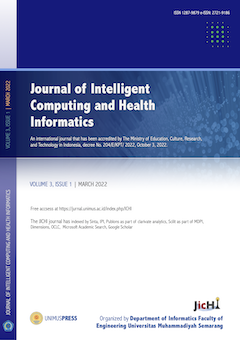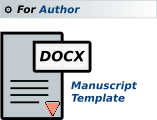Author Guidelines
[Update on April 9, 2025]
This guide outlines the structure and formatting requirements for manuscripts submitted to the Journal of Intelligent Computing and Health Informatics (JICHI). Authors are required to strictly follow the provided article template to ensure consistency and quality.
A. General Format
All manuscripts submitted to the Journal of Intelligent Computing and Health Informatics (JICHI) must be prepared using the official article template and written using Garamond font throughout the document. Research articles should range between 4,000 to 8,000 words (approximately 8–20 pages), while review articles may extend up to 30 pages. The manuscript must follow specific typographic formatting: the title must use font size 20 in bold; author names must use font size 11; affiliations and email addresses must use font size 9; the abstract and keywords section must use font size 10. For section headings such as “1. Introduction,” authors must use font size 12 in bold. The main body text of the manuscript should be written in font size 11, regular. Subsection headings (e.g., 1.1) should use font size 11 in bold, while sub-subsections (e.g., 1.1.1) must be written in font size 11 using bold italic style. Authors must adhere strictly to these formatting specifications to ensure consistency and readability across all submissions.
B. Article Structure
The manuscript must be prepared and suggested present follow the structure:
Title
The title of the manuscript must be concise, informative, and accurately reflect the core methodology, objective, and application domain of the study. It should highlight the scientific contribution and be relevant to the fields of intelligent computing and health informatics. Authors are advised to avoid vague expressions and unnecessary jargon. Titles should ideally range from 12 to 16 words and include key terms such as the technique used, the problem addressed, and the data or context involved. Abbreviations should be avoided unless well-established. The title must be written in title case and clearly align with the journal’s interdisciplinary scope.
In this context, “title case” refers to a capitalization style in which the first letter of each significant word is capitalized, while minor words such as of, and, in, for, and the remain in lowercase, unless they appear at the beginning or end of the title. For example, the following is a properly formatted title:
"Federated Deep Learning for Early Detection of Diabetic Retinopathy in Multi-Institutional Retinal Image Datasets".
Author and Affiliation Format
All author names must be written consistently using the format: Firstname Lastname. For authors with a single name (mononym), the name should be written in full without abbreviation or separation. Each author’s name must be followed by a superscript number corresponding to their institutional affiliation.
Affiliations should include only the official name of the university or higher education institution, excluding the names of departments, faculties, or programs. The institution’s name must be followed by the city and country. Institutional email addresses for each author must be clearly provided and placed directly alongside or below the corresponding affiliation.
The corresponding author must be clearly indicated by placing an asterisk (*) after the name and specifying "Corresponding Author: Full Name" below the list of affiliations. E.g:
Ahmad Ilham¹, Dewi Lestari², and Mudyawati Kamaruddin¹,*
¹ Universitas Muhammadiyah Semarang, Semarang, Indonesia; ahmad.ilham@unimus.ac.id, mudywatikamaruddin@unimus.ac.id
² Universitas Gadjah Mada, Yogyakarta, Indonesia; dewi.lestari@ugm.ac.id
*Corresponding Author: Ahmad Ilham
- Introduction. The introduction must be written briefly, concisely, and clearly. The introduction must contain an explanation of (1) the Research object, (2) Methods that have been used previously, (3) the Weaknesses and strengths of each method or may briefly allude to related work and/or hypotheses, (4) Research problems (5) Proposed solutions and/or approaches (6) List of Contributions (6) Rest of paper. The introduction section must be scientific and rich in citations. Use “maintext_FAITH” style for this paragraph.
- Preliminaries or Related Work or Literature Review. This section must contain a state-of-the-art explanation. It can be explained in several ways. First, you can discuss several related papers, both about objects, methods, and their results. From there, you can explain and emphasize gaps or differences between your research and previous research. The second way is to combine theory with related literature and explain each theory in one sub-chapter.
- Proposed Method. In this section, you need to describe the proposed method step by step. Explanations accompanied by equations and flow diagrams as illustrations will make it easier for readers to understand your research.
- Results and Discussion. In this section, the author needs to explain the hardware and software used, dataset sources, initial data analysis, results, and results analysis/discussion. Presenting the results with pictures, graphs and tables is highly recommended. Formulas or evaluation measuring tools also need to be included here. There must be discussion/analysis, and you can't just rewrite the results in sentence form, but you need to provide an explanation of their relationship to the initial hypothesis. In addition, this section needs to discuss and elaborate on important findings.
- Comparison. Comparison with state-of-the-art is an important part. This section can provide a more measurable illustration of your research contribution. This section can also be added to a brief discussion. If you feel that this section is insufficient and unsuitable to be a separate section, the author(s) can integrate this section with section four (Results and Discussion).
- Conclusions. Sections must summarize briefly and concisely the contents of the document or essay. This section may contain (1) A summary of the main results, findings, and evidence from your research or analysis. (2) Synthesis of findings, namely the relationship between findings and research objectives, and show how these findings support arguments or hypotheses. (3) The author may also be able to discuss the implications of research findings for research benefits. What is the contribution or impact on the knowledge or topic discussed? (4) Limitations and suggestions for further research.
Author Contributions
A short paragraph specifying their individual contributions must be provided for research articles with several authors (mandatory for more than 1 author). The following statements should be used “Conceptualization: X.X. and Y.Y.; Methodology: X.X.; Software: X.X.; Validation: X.X., Y.Y. and Z.Z.; Formal analysis: X.X.; Investigation: X.X.; Resources: X.X.; Data curation: X.X.; Writing—original draft preparation: X.X.; Writing—review and editing: X.X.; Visualization: X.X.; Supervision: X.X.; Project administration: X.X.; Funding acquisition: Y.Y.”
Funding
Please add: “This research received no external funding” or “This research was funded by NAME OF FUNDER, grant number XXX”. Check carefully that the details given are accurate and use the standard spelling of funding agency names. Any errors may affect your future funding (mandatory).
Data Availability Statement
We encourage all authors of articles published in FAITH journals to share their research data. This section provides details regarding where data supporting reported results can be found, including links to publicly archived datasets analyzed or generated during the study. Where no new data were created or data unavailable due to privacy or ethical restrictions, a statement is still required.
Acknowledgments
In this section, you can acknowledge any support given that is not covered by the author contribution or funding sections. This may include administrative and technical support or donations in kind (e.g., materials used for experiments). Additionally, A statement of AI tools usage transparency has been included in the Acknowledgement section, if applicable.
Conflicts of Interest
Declare conflicts of interest or state (mandatory), “The authors declare no conflict of interest.” Authors must identify and declare any personal circumstances or interests that may be perceived as inappropriately influencing the representation or interpretation of reported research results. Any role of the funders in the study's design; in the collection, analysis, or interpretation of data; in the writing of the manuscript; or in the decision to publish the results must be declared in this section. If there is no role, please state, “The funders had no role in the design of the study; in the collection, analyses, or interpretation of data; in the writing of the manuscript; or in the decision to publish the results”.
References
References must follow the IEEE citation style and include a minimum of 20 scholarly sources. We strongly recommend using a bibliography management tool such as Mendeley, EndNote, or Zotero to ensure accuracy, eliminate duplicate entries, and correctly format Digital Object Identifiers (DOIs), which must be included where available. Authors are required to prioritize references from the last 5 to 10 years, particularly those indexed in Scopus, Web of Science (WoS), or other reputable academic sources. References should primarily consist of peer-reviewed journal articles, conference proceedings, or authoritative websites that meet scholarly credibility standards.
C. Aditional Information
- Mathematical Notation: Equations must be numbered and cited in the main text.
- Theorems and Proofs: Include numbered theorems, lemmas, propositions, examples, and optional proof sections.
- Figures and Tables: All figures and tables must be clearly presented, properly labeled, and cited in the main text. Place figures and tables at the top or bottom of columns and avoid placing them in the middle. Large figures or tables may span across both columns. Each figure must include a caption below the image (e.g., Figure 1. Description), while table captions must appear above the table (e.g., Table 1. Description). Figures and tables must be inserted immediately after being cited in the text. Use consistent formatting and refer to all figures using the abbreviation “Fig.” followed by the number, even at the beginning of a sentence (e.g., Fig. 2 shows...). Tables should follow a similar citation structure and may include footnotes if necessary. All figures must be of high resolution with a minimum of 300 dpi to ensure clear reproduction in both online and printed formats. Authors must ensure that all graphical content is legible and meets professional publishing standards.









